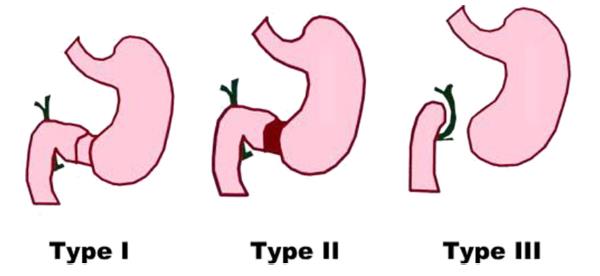(epidermolysis bullosa junctionalis-pyloric atresia syndrome)
Prevalence: < 1.106. Association of pyloric atresia (see this term) with epidermolysis bullosa (see this term) more often of the junctionalis type. Autosomal recessive transmission of a mutation of the ITGB4 gene (integrin beta 4) (17q25.1), of the ITGA6 gene (integrin alpha 6) (2q31.1) or, more rarely, of the PLEC1 gene (plectin) (8q24.)
A localized cutaneous aplasia (aplasia cutis) is associated in 28 % of cases: this is then called Bart syndrome (see this term).
There are 3 types of pyloric atresia:
- type I (60 %): presence of a membrane or one or two diaphragms in the pylorus
- type II: atresia without interruption of the digestive tract
- type III: atresia with a gap between the stomach and the duodenum.

Types II and III: polyhydramnios, single gastric air bubble on X-Ray
.jpg)
.jpg)
Mortality 75 % ( of which 50 % in neonatal period): sepsis, renal failure. The children with a mutation of the caudal part of the ITGB4 gene have a better prognosis.
Anesthetic implications:
echocardiography; neonatal upper digestive tract occlusion; management of a patient with epidermolysis (see epidermolysis bullosa).
References :
- Mylonas KS, Hayes M, Ko LN, Griggs CL et al.
Clinical outcomes and molecular profile of patients with Carmi syndrome: a systematic review and evidence quality assessment.
J Pediatr Surg 2019; 54: 1351-8.
- Alfayeza AA, Almutawab RA, Almesaiblic M, Albassamc A.
A baby diagnosed with epidermolysis bullosa associated with antral web.
J Pediatr Surgery Case Reports 2023 ; 93 : 102641, doi.org/10.1016/j.epsc.2023.102641
Updated: May 2024